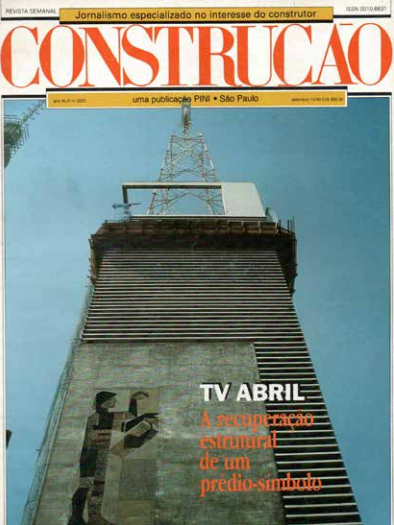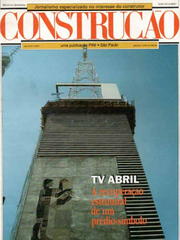
Visiting Antiga Sede da TV Tupi São Paulo, Brazil: Tickets, Hours, and Tips
Date: 14/06/2025
Introduction
The Antiga Sede da TV Tupi São Paulo stands as a monumental symbol in Brazilian and Latin American broadcasting history. As the headquarters of TV Tupi—the first television station in Brazil and South America—it is intrinsically linked to the birth and evolution of television in the region. Officially inaugurated in 1950, TV Tupi’s studios were at the forefront of pioneering programming, technological innovation, and the establishment of Brazil’s audiovisual identity. The building at Avenida Professor Alfonso Bovero, 52, is not only an architectural landmark, reflecting modernist trends and indigenous motifs, but also a testament to decades of cultural transformation and memory (Wikipedia - TV Tupi São Paulo, Museu da TV, Early Television, Ipatrimônio).
This comprehensive guide details the historical significance, architectural features, current visitor status, accessibility, travel tips, nearby attractions, and practical advice for anyone interested in exploring or understanding this iconic São Paulo historical site.
TV Tupi São Paulo: A Brief History
Origins and Foundation
TV Tupi São Paulo (PRF-3) was inaugurated on September 18, 1950, by Assis Chateaubriand, a visionary media mogul who sought to introduce television as a mass medium in Brazil. The station’s name, “Tupi,” honored the indigenous Tupiniquim people and symbolized a commitment to rooting television in Brazilian cultural identity (Wikipedia: Rede Tupi, Museu da TV). Initial broadcasts in July 1950 featured experimental transmissions, culminating in a landmark inaugural variety show that marked the dawn of Brazilian television (Early Television).
Programming and Influence
TV Tupi quickly became a trailblazer, introducing genres like telenovelas, live drama, and variety shows, while pioneering live news with “O Repórter Esso” and entertainment staples such as “Clube dos Artistas” and “TV de Vanguarda.” It launched the careers of stars like Ana Maria Braga, Chacrinha, and Hebe Camargo, and was the first Brazilian station to broadcast via satellite and in color (Wikipedia: Rede Tupi, Medium, Revista Pesquisa Fapesp).
Decline and Closure
Despite early success, TV Tupi faced mounting operational and financial crises in the 1970s. Labor disputes, mismanagement, and a devastating fire in 1978 led to the loss of broadcasting licenses and eventual closure in 1980. The building changed hands multiple times afterward and was used by MTV Brasil in the 1990s (Newqualitipedia, otvfoco.com.br).
Architectural and Cultural Significance
Designed by Gregório Zolko in the early 1960s, the headquarters is a prime example of São Paulo’s modernist movement. Its indigenous-themed panels by Gershon Kmispel evoke the Tupi heritage and remain a visual hallmark. The building’s location in Sumaré was chosen for technical advantages in broadcasting and became a creative hub for artists, journalists, and technicians (Ipatrimônio, Aroundus).
Despite decay and periods of abandonment, the structure stands as an emotional and historical beacon for those passionate about media history.
Current Status: Visiting Hours, Tickets, and Accessibility
General Public Access
As of 2025, the Antiga Sede da TV Tupi is NOT open for regular public visits. The building is privately owned, structurally compromised, and access is strictly prohibited. There are no ticket sales, visitor centers, or regular guided tours. The exterior is viewable from the street, offering a striking, if somber, landmark for amateur historians and photographers (otvfoco.com.br).
Special Events and Tours
Occasional guided tours and cultural events are organized by heritage groups or city institutions—these are rare and announced on official São Paulo tourism and cultural websites (Visit São Paulo). Interested visitors should monitor local calendars for these opportunities.
Accessibility
- Exterior: Easily accessible by metro (Sumaré Station), buses, and taxi/rideshare. The neighborhood is walkable.
- Interior: Closed to the public due to safety risks and legal restrictions. There are no facilities or wheelchair accommodations inside.
- Photography: Exterior photography is permitted and encouraged. For interior access during special events, follow organizers’ guidelines.
Travel Tips and Practical Information
- Best Time to Visit: Daytime for safety and optimal viewing/photography.
- Local Amenities: Nearby cafés and bakeries in Sumaré; limited public restrooms.
- Safety: The area is generally safe, but usual urban precautions apply.
- Language: Portuguese is predominant; translation apps are recommended for non-speakers.
- Souvenirs: No official gift shop, but memorabilia may be available at special events or in local bookstores.
Nearby Attractions
- Allianz Parque: Major sports and concert venue.
- Memorial da América Latina: Cultural complex with exhibitions and events.
- Pacaembu Stadium and Museu do Futebol: For sports and history enthusiasts.
- Cinemateca Brasileira: Holds TV Tupi archives and is open to the public for exhibitions (todasasrespostas.pt).
Frequently Asked Questions (FAQ)
Q: Can I enter the Antiga Sede da TV Tupi?
A: No, the building is closed to the public due to safety and ownership restrictions.
Q: Are there guided tours?
A: Only during special events, which are infrequent and announced by cultural organizations.
Q: What are the visiting hours and ticket prices?
A: There are no regular visiting hours or ticket sales; exterior viewing is possible at any time.
Q: Is the site accessible for people with disabilities?
A: The area around the building is walkable, but there is no interior access or specific accommodations.
Q: What cultural sites are nearby?
A: Allianz Parque, Memorial da América Latina, and the Museu do Futebol are all within easy reach.
Visual Experience
- The building’s modernist façade, indigenous-themed mosaics, and the imposing transmission tower remain visible from the street.
- For a visual tour, seek out online archives, documentaries, and high-resolution photos with descriptive alt text for accessibility (Ipatrimônio).
Cultural and Emotional Legacy
Despite decades of abandonment, the Antiga Sede da TV Tupi is a powerful symbol of Brazil’s television heritage. It evokes nostalgia and admiration among media professionals and historians, and its story is kept alive through documentaries, academic work, and online archives (uol.com.br).
Legal and Ethical Considerations
- Respect all posted barriers and legal restrictions.
- Do not attempt to enter the building, as it is unsafe and protected.
- Support preservation efforts by engaging with cultural organizations and spreading awareness.
Recommendations for Enthusiasts
- Explore online archives (Cinemateca Brasileira, TV Cultura) for TV Tupi content.
- Visit the former Cassino da Urca in Rio de Janeiro for a better-preserved TV Tupi heritage site.
- Stay informed via local media and heritage groups about any restoration or event announcements.
Internal Links & Related Content
Conclusion
The Antiga Sede da TV Tupi São Paulo is a cornerstone of Brazil’s television history and urban memory. While current access is restricted, the site offers a unique opportunity to reflect on the transformative power of media and the ongoing challenge of heritage preservation. By responsibly visiting the area, engaging with digital resources, and supporting local cultural initiatives, you help keep the legacy of TV Tupi alive for future generations.
For the latest on special events, heritage efforts, and visiting opportunities, download the Audiala app and follow relevant São Paulo cultural channels.
Key Sources
- Wikipedia - TV Tupi São Paulo
- Museu da TV
- Early Television
- Revista Pesquisa Fapesp
- Ipatrimônio
- Medium
- Newqualitipedia
- otvfoco.com.br
- Wikipedia: Rede Tupi
- Visit São Paulo
- todasasrespostas.pt




































































































































































